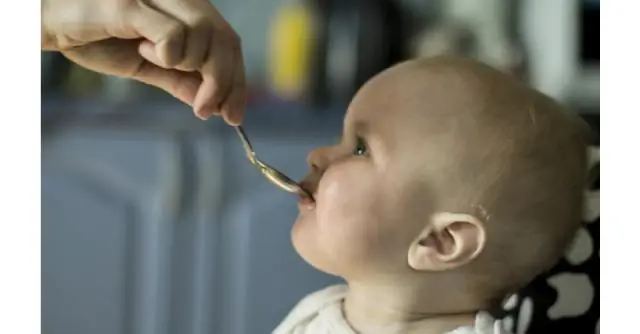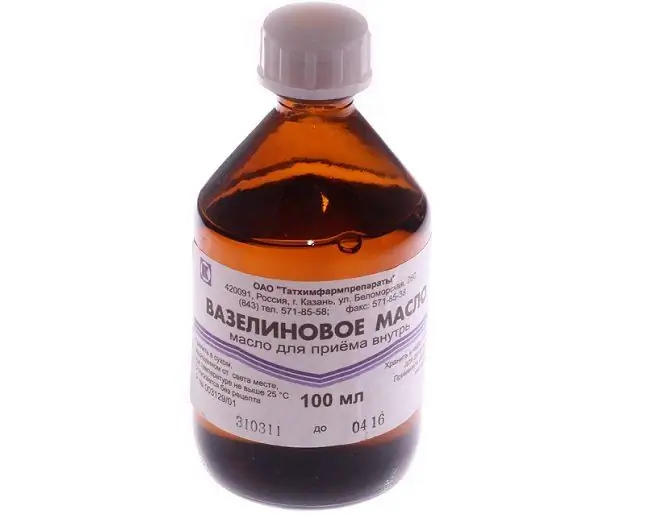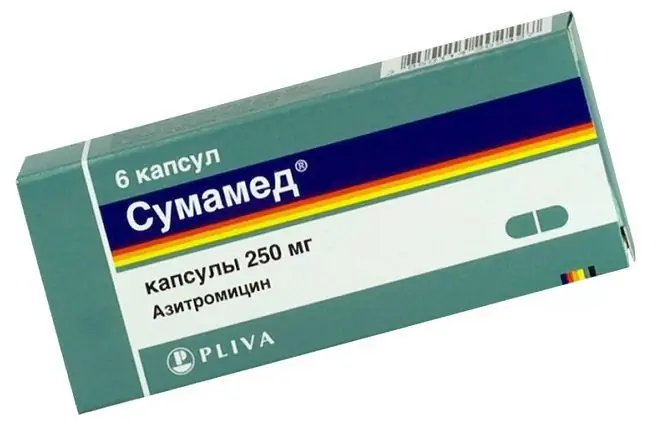- Author Rachel Wainwright [email protected].
- Public 2023-12-15 07:39.
- Last modified 2025-11-02 20:14.
Children's Panadol
Children's Panadol: instructions for use and reviews
- 1. Release form and composition
- 2. Pharmacological properties
- 3. Indications for use
- 4. Contraindications
- 5. Method of application and dosage
- 6. Side effects
- 7. Overdose
- 8. Special instructions
- 9. Use aged
- 10. In case of impaired renal function
- 11. In case of impaired liver function
- 12. Drug interactions
- 13. Analogs
- 14. Terms and conditions of storage
- 15. Terms of dispensing from pharmacies
- 16. Reviews
- 17. Price in pharmacies
Latin name: Panadol Baby
ATX code: N02BE01
Active ingredient: paracetamol (Paracetamol)
Manufacturer: FARMACLAIR (France)
Description and photo update: 2018-22-10
Prices in pharmacies: from 54 rubles.
Buy

Children's Panadol is an antipyretic analgesic.
Release form and composition
Dosage forms of Children's Panadol:
- suspension for oral administration: liquid of a viscous consistency, with crystals, pink, with a strawberry aroma (100, 300 or 1000 ml in a glass bottle of dark color, in a cardboard box 1 bottle complete with a measuring syringe);
- rectal suppositories: cone-shaped, almost white or white, in appearance - fatty, with a homogeneous structure, without foreign visible impurities and physical defects (5 or 10 pcs. in a strip, in a cardboard box 1 or 2 strips).
5 ml of suspension contains:
- active substance: paracetamol - 120 mg;
- auxiliary components: maltitol, sorbitol, 70% crystalline sorbitol, xanthan gum, citric acid, malic acid, strawberry flavor L10055, a mixture of parahydroxybenzoic acid esters (propyl, ethyl, sodium methyl parahydroxybenzoates), azorubin dye, water.
1 suppository contains:
- active substance: paracetamol - 125 or 250 mg;
- auxiliary components: solid fats.
Pharmacological properties
Pharmacodynamics
Children's Panadol is a non-narcotic drug with analgesic and antipyretic effects.
The mechanism of action is based on the effect on the centers of pain and thermoregulation as a result of blocking cyclooxygenase in the central nervous system (CNS).
Virtually no anti-inflammatory effect. When taken orally, it does not affect the synthesis of prostaglandins in peripheral tissues, therefore it does not violate water-salt metabolism and the state of the mucous membrane of the gastrointestinal tract (GIT).
Pharmacokinetics
The drug has a high degree of absorption. Absorption of paracetamol from the gastrointestinal tract when taken orally or with rectal administration occurs quickly and almost completely, which makes it possible to reach its maximum concentration (C max) in the blood plasma 0.5-1 hours after the suspension and after 2-3 hours - suppositories.
Plasma protein binding - up to 15%. Paracetamol is characterized by a relatively even distribution in tissues and body fluids.
The metabolism of the drug occurs mainly in the liver, as a result, several metabolites are formed. The main metabolite of paracetamol in children under the age of 10 is paracetamol sulfate, at the age of 12 years and older - conjugated glucuronide.
About 17% of the drug dose is hydroxylated; the resulting active metabolites are conjugated with glutathione. With an insufficient level of glutathione in the body, the active metabolites of paracetamol block the enzyme systems of hepatocytes, which can cause their necrosis.
The half-life (T1 / 2) of the therapeutic dose of the drug for the suspension is 2-3 hours, for suppositories - 4-5 hours. 90-100% of the dose of paracetamol taken within 1 day is excreted through the kidneys; the main part - in the form of metabolites and not more than 3% - unchanged.
Indications for use
According to the instructions, Children's Panadol is used to treat children with the following conditions:
- increased body temperature against the background of colds and childhood infectious diseases (including chickenpox, rubella, scarlet fever, mumps, measles), flu;
- toothache (including teething), ear pain with otitis media, or sore throat.
The suspension is also taken for headaches.
In addition, a single use of the drug is shown with an increase in body temperature after vaccination, including for taking the suspension by children from the 2nd month of life.
The form of Children's Panadol is prescribed depending on the age of the child:
- suspension: children aged 3 months to 12 years;
- rectal suppositories: at a dose of 125 mg - children from 0.5 years to 2.5 years (with a body weight of 8-12.5 kg), at a dose of 250 mg - from 3 to 6 years (with a body weight of 13-20 kg) …
Contraindications
- severe renal dysfunction;
- severe liver dysfunction;
- combination with other products containing paracetamol;
- hypersensitivity to drug components.
Additional contraindications for each of the forms of Children's Panadol:
- suspension: neonatal period, hereditary fructose intolerance;
- suppositories at a dose of 125 mg: genetic absence of the enzyme glucose-6-phosphate dehydrogenase, recent inflammation or bleeding in the rectum, blood diseases;
- suppositories at a dose of 250 mg: the period after recent inflammation or bleeding in the rectum.
Children Panadol should be used with caution in case of renal dysfunction, liver dysfunction (including Gilbert's syndrome).
Suspension and suppositories at a dose of 250 mg should be used with caution in the treatment of children with a genetic absence of the enzyme glucose-6-phosphate dehydrogenase, severe blood diseases (leukopenia, severe anemia, thrombocytopenia).
Instructions for the use of Children's Panadol: method and dosage
Oral suspension
Syrup Children's Panadol is taken orally, after shaking the contents of the bottle.
The prescribed dose is measured using the supplied measuring syringe.
A single dose for children over 3 months old is determined at the rate of 15 mg per 1 kg of body weight. The frequency of admission is 3-4 times a day.
For children aged 2-3 months and weighing 4.5-6 kg, only a doctor prescribes the dose of the drug and the frequency of use.
Recommended single dosages of Children's Panadol, taking into account the age and body weight of the child:
- 3-6 months (with a body weight of 6-8 kg): 4 ml each;
- 0.5-1 years (8-10 kg): 5 ml each;
- 1-2 years (10-13 kg): 7 ml;
- 2-3 years (13-15 kg): 9 ml;
- 3-6 years (15-21 kg): 10 ml;
- 6-9 years (21-29 kg): 14 ml each;
- 9-12 years (29-42 kg): 20 ml.
The maximum daily dosage of Children's Panadol should not exceed 60 mg of paracetamol per 1 kg of patient weight.
The duration of the course of treatment with Children's Panadol syrup without a doctor's prescription is no more than 3 days.
If there is no clinical effect after the indicated period of therapy, it is necessary to seek the advice of a doctor.
Rectal suppositories
Suppositories are used rectally, preferably after a preliminary bowel movement (spontaneous or with an enema).
The procedure for administering the drug should be carried out with the child lying on its side with the leg pressed to the stomach. With clean hands, the suppository is removed from the plastic shell and gently inserted into the anus.
A single dose of Children's Panadol is determined at the rate of 10-15 mg per 1 kg of the child's body weight.
For the treatment of children aged 0.5-2.5 years with a body weight of 8-12.5 kg, 1 piece is usually used. at a dose of 125 mg, at the age of 3-6 years (weighing 13-20 kg) - 1 pc. at a dose of 250 mg. The frequency of procedures is 3-4 times a day with an interval of 4-6 hours.
The maximum dose is no more than 60 mg per 1 kg of body weight per day or 4 suppositories.
The duration of the course without a doctor's prescription is 3 days.
If there is no positive dynamics in the child's condition after 3 days of using Children's Panadol, you should consult a doctor.
Side effects
- from the digestive system: very rarely - liver dysfunction; sometimes - nausea, vomiting;
- from the respiratory system: very rarely - bronchospasm (in children with individual intolerance to acetylsalicylic acid and other nonsteroidal anti-inflammatory drugs);
- allergic reactions: very rarely - skin rash, itching, Stevens-Johnson syndrome, urticaria, angioedema, anaphylaxis;
- from the hematopoietic system: very rarely - anemia, thrombocytopenia, leukopenia.
In addition, against the background of the use of the suspension, pain in the stomach may appear.
Overdose
Symptoms
During the first 24 hours - stomach pains, nausea, vomiting, pallor of the skin, sweating, anorexia. After 24-48 hours - a feeling of pain in the liver, increased activity of liver enzymes (signs of liver damage). Perhaps - a violation of carbohydrate metabolism, the development of metabolic acidosis.
Liver damage occurs after taking paracetamol in a single dose: adults - more than 10 g, children - more than 0.125 g per 1 kg of the child's body weight. With concomitant therapy with barbiturates, phenytoin, carbamazepine, primidone, diphenin and other anticonvulsants, rifampicin, flumecinol, phenylbutazone, zidovudine, butadione, St. occur even after taking 5 g of paracetamol.
With hepatic failure against the background of a severe degree of overdose, bleeding, encephalopathy (impaired brain function), hypoglycemia, cerebral edema (including fatal outcomes) may develop. The characteristic signs of the development of acute renal failure with acute tubular necrosis include pain in the lumbar region, hematuria, proteinuria, including in the absence of severe damage to liver function. Heart rhythm disturbances, pancreatitis are possible.
Against the background of prolonged use of high doses of Children's Panadol, the development of hepatotoxic and nephrotoxic effects (nonspecific bacteriuria, renal colic, papillary necrosis, interstitial nephritis) is possible.
Treatment
Even if an overdose is suspected and in the absence of its first symptoms, the use of the drug should be canceled and immediate medical attention should be sought. In case of an overdose against the background of rectal administration of the drug, gastric lavage or intake of enterosorbents have no therapeutic effect. Not earlier than 4 hours after an overdose, the level of paracetamol in blood plasma should be determined. Since, after an overdose, the maximum protective activity of acetylcysteine is provided during the first 8 hours, it must be administered within the next 24 hours. At a later period of administration, the effectiveness of the antidote decreases sharply. If necessary, intravenous administration of acetylcysteine is indicated. If the patient did not vomit before admission to the hospital, methionine may be used. Additional therapeutic procedures are prescribed taking into account the results of studies to determine the level of concentration of paracetamol in the blood and the period of time from the moment of taking a high dose of the drug.
Patients with severely impaired liver function should be treated with the participation of specialists in the field of toxicology or liver disease.
special instructions
Do not exceed the recommended dose!
In case of preliminary treatment of the child with other drugs, the use of Children's Panadol can be started only as directed by a doctor.
If the recommended dosage regimen is followed, paracetamol rarely causes undesirable effects.
If symptoms of side effects appear, you should stop taking Baby Panadol and immediately consult a doctor.
If you accidentally take a high dose of the drug, even if the child is in good condition, you must immediately consult a doctor to prevent the development of liver damage.
When conducting blood tests to determine the level of glucose and uric acid, it is necessary to inform the medical staff about the use of the drug.
If treatment with the drug continues for more than 7 days, the patient should be monitored for the functional state of the liver and peripheral blood parameters.
The cause of severe liver damage with a slight (5 g or more) overdose of paracetamol can be a deficiency of glutathione in the body, which can occur with indigestion, starvation or exhaustion of the patient, cystic fibrosis, HIV infection.
The use of rectal suppositories is indicated for vomiting in a child and other difficulties associated with taking the drug inside.
The content of the mixture of parahydroxybenzoic acid esters in the suspension may cause the development of delayed allergic reactions.
Pediatric use
Taking the suspension during the neonatal period is contraindicated.
Children at the age of 2-3 months and premature infants can use Children's Panadol only as directed by a doctor.
With impaired renal function
The use of Children's Panadol is contraindicated in severe renal dysfunction.
It is recommended to use all forms of the drug with caution in case of impaired renal function.
If liver function is impaired
The use of Children's Panadol is contraindicated in case of severe liver dysfunction.
Care should be taken when treating children with impaired liver function, including those with Gilbert's syndrome.
Drug interactions
With simultaneous use with Baby Panadol:
- barbiturates, phenytoin, carbamazepine, diphenin, primidone and other drugs with an anticonvulsant effect, rifampicin, flumecinol, zidovudine, phenylbutazone, butadione, St. John's wort and other inducers of microsomal oxidation, active
- cholestyramine: reduces the rate of absorption of the drug;
- inhibitors of liver microsomal enzymes: reduce the risk of hepatotoxic effects;
- chloramphenicol (chloramphenicol): increases the period of its excretion by 5 times, causing an increased risk of intoxication;
- indirect anticoagulants (coumarin derivatives): increase their effect on the background of prolonged use of paracetamol, increasing the risk of bleeding;
- metoclopramide, domperidone: increase the rate of absorption of paracetamol;
- uricosuric agents: may reduce their therapeutic effect.
Analogs
The analogues of Children's Panadol are Paracetamol, Sanidol, Pyrimol, Perfalgin, Efferalgan, Prohodol, Pacimol.
Terms and conditions of storage
Keep out of the reach of children.
Store at temperatures up to 30 ° C, the suspension - in a dark place, do not freeze.
Shelf life:
- suppositories - 5 years;
- suspensions - 3 years.
Terms of dispensing from pharmacies
Available without a prescription.
Reviews about Children's Panadol
Reviews about Children's Panadol are mostly positive. The advantages of the drug are a convenient form (suppositories and suspension) of release, significant effectiveness in pain and high body temperature, good tolerance when used in pediatric practice.
Price for Children's Panadol in pharmacies
The price for Children's Panadol for a pack (10 pcs.) Of rectal suppositories is 65-70 rubles, for a bottle of suspension - 83 rubles.
Children's Panadol: prices in online pharmacies
|
Drug name Price Pharmacy |
|
Children's Panadol 250 mg rectal suppositories 10 pcs. RUB 54 Buy |
|
Children's Panadol 125 mg rectal suppositories for children 10 pcs. RUB 58 Buy |
|
Children's Panadol 120 mg / 5 ml oral suspension 100 ml 1 pc. 84 rbl. Buy |

Anna Kozlova Medical journalist About the author
Education: Rostov State Medical University, specialty "General Medicine".
Information about the drug is generalized, provided for informational purposes only and does not replace the official instructions. Self-medication is hazardous to health!






